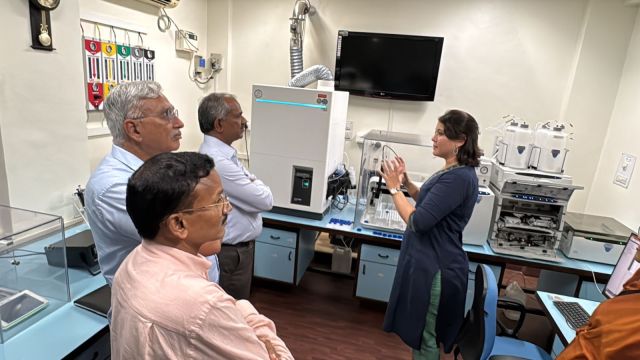Click here to join Express Pune WhatsApp channel and get a curated list of our stories
In a first, IITM Pune sets up dedicated lab to study toxicity of air pollutants, health risks they pose
The Atmospheric Chemistry Laboratory at the Indian Institute of Tropical Meteorology (IITM) in Pune is equipped with cutting-edge analytical instruments, including Aerosol Mass Spectrometers, says scientist Sachin Ghude.
 The lab specifically focuses on analysing the chemical composition and toxicity of PM1, PM2.5, and PM10, which are among the most harmful pollutants affecting urban populations. (Express photo)
The lab specifically focuses on analysing the chemical composition and toxicity of PM1, PM2.5, and PM10, which are among the most harmful pollutants affecting urban populations. (Express photo)
In a first, the Indian Institute of Tropical Meteorology (IITM) in Pune recently set up an Atmospheric Chemistry Laboratory to decode the complex chemical composition of airborne particles and assess their impact on air quality, health, weather patterns, and climate systems.
The laboratory is a flagship initiative under the Mission Mausam project. IITM scientist Sachin Ghude, who is the lab’s project director, said they aimed to develop a next-generation air quality prediction model capable of forecasting not only pollution levels but also the chemical toxicity and associated health risks.
Ghude has made significant contributions in both observational and modelling aspects of atmospheric chemistry that culminated in the development of an operational early warning system for winter fog and air quality. He told The Indian Express that unlike traditional systems that measure only the mass of particulate matter (PM), this laboratory goes a step further to break down particles into their chemical components, such as heavy metals, toxic organics, and trace elements.
The lab specifically focuses on analysing the chemical composition and toxicity of PM1, PM2.5, and PM10, which are among the most harmful pollutants affecting urban populations.
“Early findings already reveal that toxicity does not scale linearly with particle mass. Even low concentrations of PM can be highly hazardous, depending on their chemical makeup. Also, an additional focus includes detecting airborne and waterborne micro- and nano-plastics, a growing threat to both ecosystems and human health,” he said.
The lab will also work on getting a better understanding of how aerosol chemistry influences cloud formation, radiation balance, and fog events, offering insights into regional weather and climate systems.
Different from SAFAR, WiFEX labs
While the System of Air Quality Forecasting and Research (SAFAR) monitors ambient levels of pollutants like PM2.5, PM10, CO, NOx, O₃, and volatile organic compounds (VOCs), it does not analyse their chemical composition or toxic potential. The Winter Fog Experiment (WiFEX) primarily focuses on fog processes and meteorological dynamics over the Indo-Gangetic Plains, studying how aerosols interact with fog but without detailed chemical resolution.
“In contrast, the Atmospheric Chemistry Laboratory is India’s first dedicated platform to integrate chemical characterisation, toxicity analysis, and health impact modeling, making it a complementary yet uniquely powerful tool in the national atmospheric research ecosystem,” Ghude said.
To achieve its high-resolution scientific goals, the lab is equipped with cutting-edge analytical instruments, including: Aerosol Mass Spectrometers (AMS), Gas and Liquid Chromatographs, High-Resolution ICP-MS (Inductively Coupled Plasma Mass Spectrometer), Thermal-Optical Carbon Analysers and instruments for detecting micro- and nanoplastics in air and water. Some of these have already been deployed, and additional instruments are being procured to complete the setup.
Samples will be collected across multiple regions of India, including urban centres where SAFAR and MAPAN (Micrometeorological and Air Pollution Assessment Network) stations are active.
Additionally, sampling campaigns will be conducted in Himalayan regions and oceanic outflow zones, including Andaman and Lakshadweep, to capture the diversity of aerosol sources and transport pathways.
The initiative is a strategic step toward meeting India’s sustainable development and climate goals under the Viksit Bharat 2047 mission, Ghude said. The lab has a five-year scientific roadmap aimed at building national capacity in chemical and health-based air quality forecasting.
By the end of this period, the aim is to deliver an operational toxicological air quality forecasting system, set up a national database of aerosol chemical composition, provide policy-relevant insights for health advisories and emission control, and contribute to global climate models with more accurate aerosol input.
Click here to join Express Pune WhatsApp channel and get a curated list of our stories








